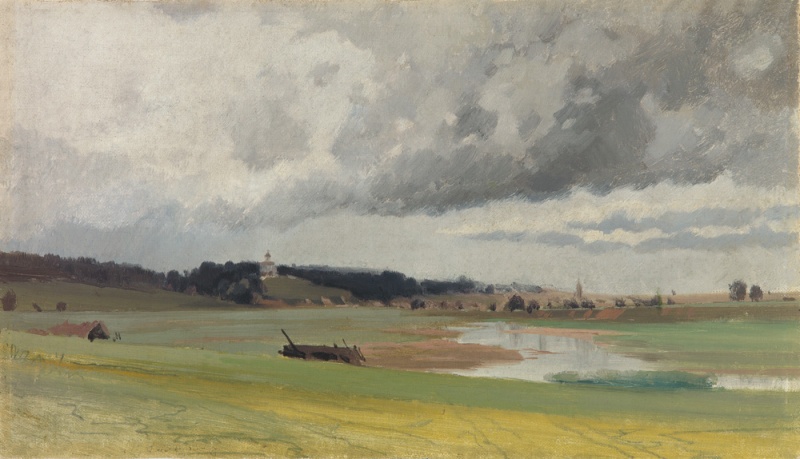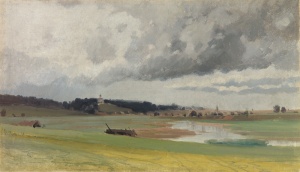
Landscape with Storm Clouds
| Author: | Isaac Levitan (1860/1861–1900) |
Isaac Levitan’s (b. 1860/1 Kybartai – d. 1900 Moscow) father worked in the ticket office at the railway station in Virbaliai. In the early 1870s, the family moved to Moscow with their four children. In 1873, the 13-year-old Isaac entered the Moscow School of Painting and Sculpture as the first Jewish student. Due to personal circumstances (his mother died in 1875, and his father died in 1877), and political vicissitudes, he did not finish school until 1883. He travelled to Germany, France, Italy and Switzerland, and participated in exhibitions in Munich, Vienna and Paris. In 1898, he was awarded the title of Academician, and was allowed to teach at the Moscow School of Painting and Sculpture. Levitan became famous for his landscapes, which were infused with space, freshness and movement. He was able to convey the slightest changes in nature: rustling leaves, rippling water, evaporating dew, blowing clouds. The art critics called him ‘a bard of Russian nature’.
Source: Ellex Valiunas (LAWIN until 2015) art album: STORIES OF LITVAK ART (2023). Compiler and author Vilma Gradinskaitė.
Isaak Levitan was born on 30 August 1860 in Kybartai, into the large family of a railway worker. Later he lived in Kaunas. He enrolled in the Moscow School of Painting, Sculpture and Architecture at the age of 13. Three years later he moved to the studio of the eminent landscapist Alexei Savrasov, and later became a student of Vasiliy Polenov. When he was 19, he painted a picture which attracted the attention of Pavel Tretyakov, and which is now displayed in the halls of the Tretyakov Gallery. In 1885 he became acquainted with Anton Chekhov, with whom he remained friends for the rest of his life. His work was greatly influenced by his three-year stay on the River Volga, from 1887 to 1890, where he was mesmerised by the expanse of space, the pristine nature, and the feeling and meditativeness aroused by natural forces about the continuity of nature and the fraility of human existence. This gave rise to his lyrical and epic landscapes Eternal rest, By the pond and Spring floods. In the lively landscapes he painted during the last five years of his life, Levitan tried to render the fleeting conditions of nature in simple artistic language.
Levitan became a member of the Imperial Academy of Arts in 1898, and was made head of the Landscape Studio of the Moscow School of Painting, Sculpture and Architecture. His pictures were exhibited abroad. But his health deteriorated due to heart disease, and he died in Moscow two years later, on 4 August 1900.
Source: Valiunas Ellex (LAWIN until 2015) art album: THE WORLD OF LANDSCAPES II (2013). Compiler and author Nijolė Tumėnienė.

Isaac Levitan’s (b. 1860/1 Kybartai – d. 1900 Moscow) father worked in the ticket office at the railway station in Virbaliai. In the early 1870s, the family moved to Moscow with their four children. In 1873, the 13-year-old Isaac entered the Moscow School of Painting and Sculpture as the first Jewish student. Due to personal circumstances (his mother died in 1875, and his father died in 1877), and political vicissitudes, he did not finish school until 1883. He travelled to Germany, France, Italy and Switzerland, and participated in exhibitions in Munich, Vienna and Paris. In 1898, he was awarded the title of Academician, and was allowed to teach at the Moscow School of Painting and Sculpture. Levitan became famous for his landscapes, which were infused with space, freshness and movement. He was able to convey the slightest changes in nature: rustling leaves, rippling water, evaporating dew, blowing clouds. The art critics called him ‘a bard of Russian nature’.
Source: Ellex Valiunas (LAWIN until 2015) art album: STORIES OF LITVAK ART (2023). Compiler and author Vilma Gradinskaitė.
Isaak Levitan was born on 30 August 1860 in Kybartai, into the large family of a railway worker. Later he lived in Kaunas. He enrolled in the Moscow School of Painting, Sculpture and Architecture at the age of 13. Three years later he moved to the studio of the eminent landscapist Alexei Savrasov, and later became a student of Vasiliy Polenov. When he was 19, he painted a picture which attracted the attention of Pavel Tretyakov, and which is now displayed in the halls of the Tretyakov Gallery. In 1885 he became acquainted with Anton Chekhov, with whom he remained friends for the rest of his life. His work was greatly influenced by his three-year stay on the River Volga, from 1887 to 1890, where he was mesmerised by the expanse of space, the pristine nature, and the feeling and meditativeness aroused by natural forces about the continuity of nature and the fraility of human existence. This gave rise to his lyrical and epic landscapes Eternal rest, By the pond and Spring floods. In the lively landscapes he painted during the last five years of his life, Levitan tried to render the fleeting conditions of nature in simple artistic language.
Levitan became a member of the Imperial Academy of Arts in 1898, and was made head of the Landscape Studio of the Moscow School of Painting, Sculpture and Architecture. His pictures were exhibited abroad. But his health deteriorated due to heart disease, and he died in Moscow two years later, on 4 August 1900.
Source: Valiunas Ellex (LAWIN until 2015) art album: THE WORLD OF LANDSCAPES II (2013). Compiler and author Nijolė Tumėnienė.






